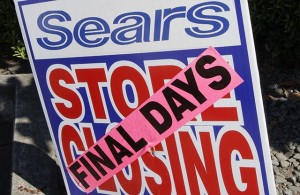Store closings, well above the usual level of trimming retailers do annually, are expected this year.
By David Moin | January 25, 2017
The shakeout has arrived.
For retailers across the nation and up and down the price spectrum, 2017 will be a year of dramatic square footage reduction — and no one is being coy about it.
“Brick-and-mortar retailers will evaluate store fleets relative to e-commerce and make decisions on what they believe to be the right ratio of stores to e-commerce,” Marvin Ellison, Penney’s chairman and chief executive officer, told WWD at an industry fundraiser earlier this month.
It was one of those feel-good kind of evenings — 1,500 people raising $3.5 million for YMA scholarships and programs — but an undercurrent of concern over the state of retailing permeated the crowd in the ballroom of the Grand Hyatt. Consumers have more disposable cash, the stock market is hitting all-time highs, yet there are just too many stores, too much stuff on the shelves and not enough demand. Selling floors have been sapped of business by Amazon and other online players, many malls are losing traffic and retailers are finally coming to terms with what must be done to right-size their store fleets for a better future.
“We have closed stores before, but very conservatively, basing our decisions on four-wall free cash flow — not e-commerce,” Ellison said as he stood alongside John Tighe, Penney’s chief merchant and one of the evening’s honorees. Regarding how many Penney’s units will close, “that’s to be determined,” Ellison said.
Howard Schultz, chairman and outgoing ceo of Starbucks, actually set the tone in December when he said, “We’re going to see a very major downturn in the fact that the country is overretailed in lots of categories.” Ironically, he made the statement while unveiling the coffee chain’s five-year strategic plan to open 12,000 stores by 2021.
Macy’s reinforced the issue right after the New Year, stating that 63 stores would close in 2017 and about another three dozen over the next few years, triggering speculation about a major wave of retail downsizings.
“Macy’s is just the tip of the iceberg,” said Stephen I. Sadove, the former Saks Fifth Avenue chairman and ceo, who was interviewed at the NRF Foundation Gala on Jan. 15. Asked what other retailers he sees downsizing, Sadove replied, “They all will. We don’t need as many stores.”
Some retail experts expect Forever 21, Gap Inc., Abercrombie & Fitch Co., Bon-Ton Stores Inc., Barnes & Noble, Bed Bath & Beyond, HH Gregg, Ascena Retail Group, and a handful of upscale and luxury chains to reduce store counts beyond the normal amount of trimming they do each year.
They pointed to American Apparel recently shutting its entire chain, Limited in the process of doing the same and Sears Holdings indicating this month that 109 Kmarts and 41 Sears units would close this year. They have all been suffering from internal and macro issues. According to The Centurion newsletter for prestige jewelers, about 2,000 jewelry stores shuttered in North America from 2015 through 2016, and closings will continue.
Those predicting a great shakeout cite eye-opening statistics from the International Council of Shopping Centers that there are 24 square feet of shopping center space per capita in the U.S., compared with 15 square feet in Canada, five square feet in the U.K., four square feet in France and three square feet in Italy.
“For the most part, it’s those ‘B’ and ‘C’ malls that are going to have to be very creative about repurposing. There are not tenants of comparable size replacing department stores that are closing,” said Antony Karabus, ceo of HRC Retail Advisory.
But there are alternative ways to repurpose the disappearing big boxes into multiple uses.
Brands emerging out of the web will take retail space, including Amazon, Warby Parker, Combatant Gentleman, Bonobos and possibly QVC and HSN. Eloquii, the web site for the contemporary, fast-fashion apparel brand for women’s sizes 14 to 28, will test brick-and-mortar for the first time in March with a “concept shop” in the Fashion Centre at Pentagon City in Arlington, Va.
Off-pricers also could fill space, including Century 21, the Home Goods division of The TJX Cos., Bloomingdale’s Outlets and Macy’s Backstage, which is primarily carving out space inside Macy’s department stores.
Also on the expansion track: Zara, the Spanish fast-fashion chain; Francesca’s, the fast-growing retailer targeting 18- to 35-year-old women; Five Below, another rapidly expanding chain where everything is $5 or less; Petsmart; Massage Envy; new formats from Nike, Adidas and Under Armour, and Gap Inc.’s Athleta division. Costco is seen opening locations on an “opportunistic” basis, and so could Primark, the chain from Ireland with dirt-cheap prices that in 2015 opened its first U.S. store in Boston and has converted parts of several former Sears sites for additional stores. On the beauty front, Sephora, Bluemercury and Ulta continue to expand.
But these openings are most likely only a drop in the bucket.
On a smaller scale, regional chains such as Belk and Von Maur that have strength in their core markets could pick up a few vacated properties. And some emerging specialty stores, such as Flying Tiger, the Danish chain with low prices, quirky products and whimsical designs, and Kendra Scott, the jewelry and home store chain, could take some space.
Groceries — Trader Joe’s, Wegman’s and Whole Foods among them — and emerging health and fitness clubs such as Life Time and Point of Fitness, are seen as potential remedies for anemic mall traffic, particularly on weekdays when business is slower than weekends.
Skating rinks, comedy clubs, yoga centers, health clinics and incubators for tech and retail concept incubators and pop-ups could be added.
Even more imaginative would be converting mall space to central shipping areas that retailers could piggyback off of; partnering with Disney on innovative concepts, and adding food halls, à la Eataly, viewed as strong destinations in heavily populated areas and alternatives to conventional food courts.
Sadove said retailers must sharpen the focus on the stores worth investing capital in and those stores not worth investing in. To be successful, “you’ve got to keep a store fresh,” he said. But the issue is there is only so much that can be spent on stores given the imperative to spend on new technologies, web site enhancements and omnichannel initiatives.
“We are statistically overstored relative to any other population,” said Steve Goldberg, president of The Grayson Company consulting firm. “As you see the share of spend shifting to digital platforms, it exacerbates the situation. What we are going to continue to see is a rationalization of retail. In the case of Macy’s, what we are seeing is a continued unwinding of stores that were probably underproductive or less productive for years. We will see more closures of department stores for the very same reasons, without any question this year.…On the other hand, other stores will increase their footprint. Primark is opening stores. The off-price sector just can’t get enough growth. Brick-and-mortar is emerging out of the web.”
Wal-Mart will continue to rationalize space by moving to smaller formats, “closing some doors and replacing them with smaller ones. Target probably is in an OK place,” said a retail source.
“Some malls are not going to have any anchors,” said Goldberg. “In some cases, they will get torn down. They just won’t be viable. In other cases they will be repurposed. There are all kinds of concepts emerging that could take the place of department store footprints, from sport facilities to entertainment environments. However, that’s not going to come without significant costs. I’ve also heard talk about medical facilities, office facilities, even residential use.”
“We are fully expecting to see another wave of announcements over the next five or six weeks,” said Lea Overby, managing director of research, structured finance, Morningstar Credit Ratings, regarding store closings. “It’s a fascinating time to be looking at retail. Will it be worse than last year? Probably. Worse than 2009? I’m not so sure. I don’t know if we are going to see that sort of mass disruption with entire sectors getting reconfigured. It will feel like a slow bleed rather than a major hemorrhaging. You might see announcements from companies you might not otherwise expect. Watch the ones that have surprise negative sales. In particular, watch the higher-end retailers.”
“I’m not convinced we are going to see a massive contraction of square footage. I am convinced we are going to see a massive amount of effort to bring higher value to brick-and-mortar in ways that match how consumers want to shop these days and bring digital tools to the physical space,” observed Stefan Weitz, chief product and strategy officer of Radial, a firm that helps retailers with a range of operations and services including logistics, payments and fraud prevention. He sees stores working to provide easier access to products and product information and reviews, so there’s a lot less rummaging.
“It’s about keeping people in stores longer,” Weitz added, noting that Nordstrom’s cocktail bars in certain locations is one way to do it. “While customers are sitting there, it’s an opportunity to message them.”
“We are in the midst of a major correction,” said Marshal Cohen, chief industry analyst for The NPD Group. “As online becomes more applicable to bigger audiences, everyone is looking at stores with a different set of eyes, and retailers are scrutinizing their store portfolios to make sure every single store carries its own weight. Stores need to go from being product suppliers to lifestyle enablers. They need to figure out how to make my life better. We are spending more money than ever, but not buying more products than ever.”
He suggested a return to the old days when department stores were emporiums filled with hair salons, restaurants, fashion shows, or as he put it, “All kinds of lifestyle and life-enhancing experiences that drive me into the store — an omnipresence package.
“There are too many retail stores at the moment lacking innovation, lacking uniqueness. So many brands all look the same,” Cohen said. “I don’t rule out any retailer looking at every single store and closing 10, 20 or 60 over the next few years. It is overdue.”
“It’s not a new issue that the country is overstored. But it’s reached a tipping point with the growth of online sales,” said Craig Johnson, president of Customer Growth Partners. “There really needs to be a trimming at the margin to right size. There’s rampant overcapacity and a need for major restructuring.”
Johnson said shopping centers in the U.S. have 23 square feet of retail space per capita, and that there are 45 square feet of retail capacity per capita overall. “Those numbers have been essentially level for at least five years. Meanwhile, online sales this holiday
“Retailers that owned their own real estate have been loath to repurpose it, particularly department stores,” Johnson said. He sees Sears, Dillard’s and Macy’s all as being at overcapacity.
“Nordstrom is a slightly different animal. Their full-line stores have been challenged, but they are not as over-capacitated as the others,” he added.
Still, there is no doubt that executives need to implement some major surgery. “There is a growing expectation that something bold needs to happen,” said Greg Portell, head of A.T. Kearney’s retail practice. “Expect investors to look for management teams that make that bold action. Those that chop off one branch at a time from the tree are going to be stuck.”
To view the published article, click here.




